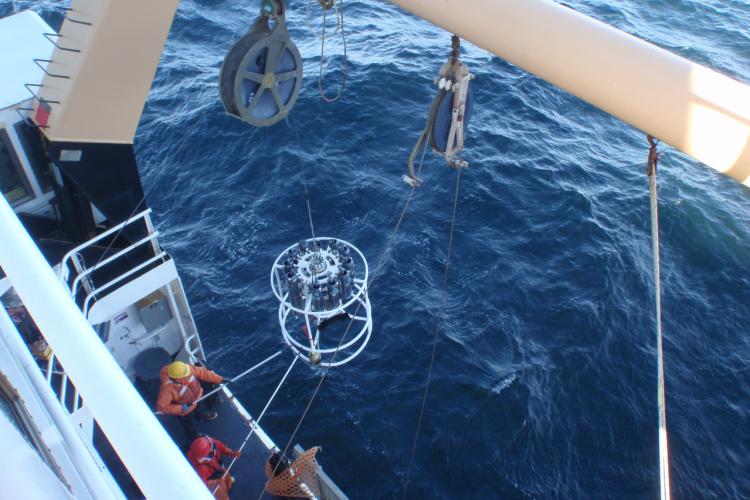Oceanographic data collections, when combined with fish data, help better understand ecosystem processes and how those processes affect various fisheries.
Data Collections
Physical and Chemical Data
- Temperature
- Conductivity
- Salinity
- Density
- Light Transmission
- Photosynthetically available radiation (PAR)
- Oxygen
- Chlorophyll a
Biological Data
- Phytoplankton
- Zooplankton
- Jellyfish
- Phytoplankton growth experiments (Primary Production)
Oceanography Data can be found on the Alaska Ocean Observing System (AOOS) Bering Arctic Subarctic Integrated Survey (BASIS) data collection.
Contacts
Recent Research Publications
Lomas, Michael W., Eisner, Lisa B., Gann, Jeanette., Baer, Steven E., Mordy, Calvin W., Stabeno, Phyllis J.
2020. Time-series of direct primary production and phytoplankton biomass in the southeastern Bering Sea: responses to cold and warm stanzas. Mar Ecol Prog Ser, Vol 642: 39-54. DOI: https://doi.org/10.3354/meps13317
S. L. Danielson, O. Ahkinga, C. Ashjian, E. Basyuk, L. W. Cooper, L. Eisner, E. Farley, K. B. Iken, J. M. Grebmeier, L. Juranek, G. Khen, S. R. Jayne, T. Kikuchi, C. Ladd, K. Lu, R. M. McCabe, G. W. K. Moore, S. Nishino…, T. J. Weingartner
2020. Manifestation and consequences of warming and altered heat fluxes over the Bering and Chukchi Sea continental shelves. Deep-Sea Res. II, in press. DOI: https://doi.org/10.1016/j.dsr2.2020.104781
James T Thorson, Charles F Adams, Elizabeth N Brooks, Lisa B Eisner, David G Kimmel, Christopher M Legault, Lauren A Rogers, Ellen M Yasumiishi
Seasonal and interannual variation in spatio-temporal models for index standardization and phenology studies, ICES Journal of Marine Science, , fsaa074, https://doi.org/10.1093/icesjms/fsaa074
Hunt, G., Renner, M., Kuletz, K., Salo, S., Eisner, L., Ressler, P., Ladd, C., Santora, J.
2018. Timing of sea-ice retreat affects the distribution of seabirds and their prey in the southeastern Bering Sea Mar. Ecol. Prog. Ser. DOI: https://doi.org/10.3354/meps12383
Hertz E, Trudel M, Carrasquilla-Henao M, Eisner L and others
2018. Oceanography and community structure drive zooplankton carbon and nitrogen dynamics in the eastern Bering Sea. Mar Ecol Prog Ser 601:97-108. https://doi.org/10.3354/meps12647
Ladd, C., Eisner, L. B., Salo, S. A., Mordy, C. W., & Iglesias‐Rodriguez, M. D.
2018. Spatial and temporal variability of coccolithophore blooms in the eastern Bering Sea. Journal of Geophysical Research: Oceans, 123, 9119–9136. https://doi.org/10.1029/2018JC014302
Santora, J., Eisner, L., Kuletz, K., Ladd, C., Renner, M., Hunt, G.
2018. Biogeography of seabird assemblages in the eastern Bering Sea: regional structuring in relation to environmental determinants along latitudinal gradients. J. Marine Syst. 178: 38-51. (oceanographic, zooplankton and age-0 pollock data)



